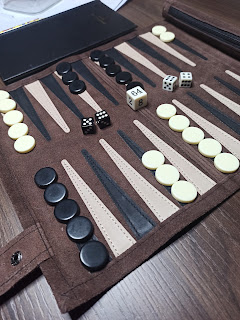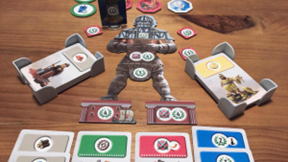Euro-style board games have gained immense popularity in recent years, captivating gamers with their emphasis on strategic gameplay, economic systems, and thematic depth. While most euro games cater for 2-4 players, several titles offer expanded player counts, extending the gaming experience to 5 or 6 participants. However, the decision of whether to design a game for a specific player count or accommodate a wider range involves careful consideration, as each approach presents its advantages and disadvantages.
Games specifically designed for 4 players often offer a more refined and cohesive experience. By carefully tuning the game mechanics and balancing the elements, designers can ensure that every player has ample opportunities to engage in meaningful strategic decisions without feeling overwhelmed or marginalized. This focus on a smaller player count allows for a more intimate and interactive gaming experience, fostering a sense of camaraderie and engagement among participants.
In contrast, games designed for 5 or 6 players often provide a more expansive and dynamic playing field, offering a greater range of strategic possibilities and potential interactions. With more players involved, the game can evolve in unexpected ways, leading to unpredictable outcomes and a greater sense of unpredictability. This can be particularly appealing to gamers who enjoy the excitement of adapting their strategies to the ever-changing dynamics of a larger game.
A common approach to expanding the player count for popular euro games is to introduce expansions or add-ons that introduce new elements and mechanics specifically designed for larger groups. While this can provide additional options for those seeking a more player-heavy experience, there are several drawbacks to consider.
Adding new mechanics and components can introduce complexity that can be overwhelming for new players or those who prefer a more streamlined gaming experience. Expanding the player count can disrupt the carefully balanced mechanisms of the core game, leading to imbalances or unintended outcomes. Adding more players typically translates to a longer playing time, which may not be suitable for all groups or occasions.
When choosing a Euro-style game for a group of 4-6 players, it's essential to consider the group's preferences and gaming style. For those who enjoy a more intimate and strategic experience, games specifically designed for 4 players are generally ideal. For groups seeking a more expansive and dynamic game, titles designed for 5 or 6 players can provide an enjoyable and engaging experience.
In the case of games originally designed for 4 players and later upgraded with expansions for larger groups, it's advisable to carefully evaluate the expansion's impact on the core game's balance, complexity, and overall experience. If the expansion introduces significant changes that may detract from the original gameplay, it may be more suitable to choose a game that was designed for a larger player count from the outset.
Similarly, numerous games were originally crafted for two players but have been revisited and adapted to accommodate four players due to the game's widespread popularity and its perceived feasibility at that player count. This growing trend among game designers reflects their desire to broaden the game's appeal and make it more accessible to a wider audience. While this approach undoubtedly expands the game's reach, it also introduces several challenges and considerations that designers must carefully address
.jpeg)
Adapting a two-player game to four players can be a delicate balancing act, as it requires carefully addressing several potential issues. For example, scaling the game mechanics and player interactions to accommodate four players can be tricky, as the dynamics and strategies may change significantly. In these cases, it becomes crucial to ensure that the game remains balanced and enjoyable for all players, without overwhelming the experience for newcomers or diluting the strategic depth for experienced players.
Adding more players typically introduces more complexity, both in terms of rules and gameplay. This can be challenging for newcomers or those who prefer a streamlined experience.
Furthermore, expanding the player count can stretch the game's core concept, potentially diluting the unique gameplay elements that made the two-player experience so engaging. There exists a very real possibility that the game's identity could become derailed in the process that the game starts to feel less cohesive or complementary to the original experience.
Despite these challenges, there have been several notable examples of two-player games that have successfully transitioned to four-players. These adaptations demonstrate the potential for expanding a game's appeal while maintaining its core gameplay and strategic depth.
Despite being designed for two players, Ascension and its expansions can be adapted for four-player games, albeit with some adjustments. The core gameplay remains the same, but with an increased "Honour" pool to draw from. The game progresses more slowly at four, and player turns become more intricate towards the end. This makes Ascension a better choice for two-player matches, where players can focus on synergistic card combos and deck optimization.
While Star Realms is primarily designed for two players, it can also be enjoyed in four-player games. These games can take two forms: a chaotic Battle Royale mode and a more structured two-versus-two mode.
In Battle Royale, players can attack any opponents they choose, with the only restriction being that no player can be targeted by two consecutive attackers. This format can lead to a frenetic and unpredictable middle game as players jockey for position and eliminate opponents. The chaos continues until only two players remain, at which point the game reverts to a standard Star Realms match.
The two-versus-two format is a more manageable option. Teams share a pool of Authority points and work together to deplete their opponents' points to zero. The key rule in this format is that no team member can take two consecutive turns. The added social element of this mode comes from the ability of team members to strategize together during their turns. Magic The Gathering, originally designed for two players, has been adapted to accommodate four, albeit with significant adjustments. The first alteration in the so-called “Commander Deck” variant, involves deck size, with each player now constructing a 99-card deck plus a commander card. This expansion in deck size leads to longer game durations, sometimes stretching up to 90 minutes or more. Additionally, each player's life total is increased to 40 from the standard 20. This change is primarily motivated by the desire to create a more engaging multiplayer experience, which is lacking in the standard format. The popularity of this four-player variant largely depends on the preferences of individual groups. While it sacrifices some of the concentrated strategic flow of standard play, it introduces greater interaction and complexity, making it a more dynamic and unpredictable experience.
While many games claim to be suitable for 2 to 4 players, some shine brightest at lower player counts. These games excel at creating a more intimate and fulfilling experience, allowing for deeper engagement and strategic interplay between players. Let's explore some of these exceptional games.
Wingspan is a game that successfully transitions from two to four players without compromising its core gameplay. While the competitive aspect remains, it does not overly interfere with other players' strategies. Its engine-building structure, coupled with elements of card drafting, action selection, and worker placement, ensures that turns are efficient and seamless. This fluidity makes it easy to scale up the game to four players without significantly altering the gameplay experience.
Splendor is a game that adapts well to different player counts, offering a strategic and engaging experience for both two and four players. At two players, the game is characterized by tight tactics and a focus on anticipating and countering your opponent's moves. It's a delicate dance of manoeuvring, balancing aggressive blocking with relentless point acquisition.
When playing with four players, an element of complexity is introduced due to the increased number of actions and interactions that occur during each turn. This can lead to unexpected changes in strategy and require players to recalibrate their approach frequently. The game becomes more dynamic and open to the influence of other players' actions, adding an element of unpredictability. However, this can also extend the game's length, especially if players tend to overthink their moves and analyse every possible scenario.
Although Carcassonne is not specifically tailored for two-player gameplay, it shines exceptionally at this player count. The game's strategic depth and tactical possibilities are particularly alluring when played with two players. Despite accommodating four players, the game becomes more intricate and unpredictable at this number. Conversely, other tile-laying games like Land & Sea prioritize a more focused two-player approach while offering a three-player option for those seeking a larger group experience. However, the effectiveness of this three-player variant remains open to debate.
The reason for addressing this flexibility when it comes to player counts is truly all about leveraging a board game collection to maximise the return on its initial investment. I like to think of a game in terms of its value when it comes to the number of games I played as well as the number of players that have sat down to play it. Let us look at an example here.
Let us say I have a game, a two-to-four-player game with simple rules and a brisk gaming pace. Let us for the sake of argument say that I bought it for €40 and that to date I have managed at least 12 games with, on average 3 players. On a simple level, I can say that the game gave me a pleasurable social experience at a cost of approximately €3.30 per game. If on average, I played with 3 players then we are saying that offering that experience to my players cost me approximately €1.10 per person. In my books, that game is worth the money spent on it.
On the other hand, if I spend around €70 and manage only a measly 2 plays with 4 players. We are looking at a rather expensive game where the cost per play would stand at €35 per game or around €8.75 per player at the table. From this perspective, it becomes evident that bringing a game to the table repeatedly is crucial to justify its existence. The more times a game is played, the greater the value it holds. For this reason, games that scale well are more likely to be played multiple times. Exclusively two-player games should avoid being overly lengthy or structured as campaign experiences. Alternatively, such games should provide an option for one-off playthroughs to increase the likelihood of being played.
In summary, not every game adapts equally well to different player counts. Some games excel at 4 players and scale gracefully to 6, while others struggle to maintain the same level of enjoyment at higher player counts. The same applies to 2-player games or those marketed as 2-4 players. The number of decisions per turn often plays a crucial role in scalability. However, even with streamlined turns, it's often necessary to experience a game first-hand to determine its ideal player count for your group.
My advice is straightforward. Don't just take the game's box at its word when it claims to scale well. Do your research, read as many reviews as possible and watch a few related videos. Seek out diverse sources to gather a range of opinions. Once you've gathered all this information, consider the specific player count that suits your group's preferences and dynamics. Most importantly, choose games that you think will get played, or you could end up with expensive board games that end up gathering dust on your shelf.





.jpeg)
.jpeg)

































